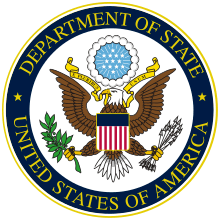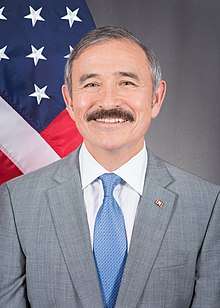List of ambassadors of the United States to South Korea
| Ambassador of the United States to South Korea
주한미국대사 | |
|---|---|
 Seal of the United States Department of State | |
| Nominator | President of the United States |
| Inaugural holder |
Lucius H. Foote as Envoy, Resident Minister and Consul-General |
| Formation | 1883 |
| Website | U.S. Embassy - Korea |
The United States Ambassador to South Korea is the chief diplomatic representative of the United States accredited to the Republic of Korea. The ambassador's official title is "Ambassador Extraordinary and Plenipotentiary of the United States of America to the Republic of Korea."[1]
The current ambassador, Harry B. Harris Jr., who previously served as an admiral in the United States Navy, was sworn in on June 30, 2018.[2]
Joseon and Korean Empire
After the United States–Korea Treaty of 1882 was negotiated, diplomatic representatives were sent from Washington to Seoul.[3] From then until 1905, there were several Envoys and Consuls General, each heading what was called a legation. After the Japanese had defeated the Chinese in 1895, and the Russians in 1905, Korea began to see its independence disappear. By 1910, Japan had annexed Korea and the U.S. no longer had a diplomatic presence in Korea.
Envoy, Resident Minister and Consul-General
| Period | Name | |
|---|---|---|
| 1883–1885 | Lucius H. Foote | [4] |
| 1886 | William Harwar Parker | |
| 1887–1890 | Hugh A. Dinsmore | [5] |
| 1890–1893 | Augustine Heard | [4] |
| 1894–1897 | John M.B. Sill | [4] |
| 1894–1897 | Horace Newton Allen | [4] |
| 1905 | Edwin V. Morgan | [6] |
Republic of Korea
At the end of World War II, American forces accepted Imperial Japan's surrender in southern Korea, and Soviet forces accepted the surrender of the Japanese in northern Korea. Talks to agree upon a unity government for Korea failed and in 1948, two separate Korean states were created: the Republic of Korea (South Korea) and the Democratic People's Republic of Korea (North Korea). The United States established diplomatic relations with the new South Korean government, but did not recognize North Korea. Other countries, like the Soviet Union, recognized the Pyongyang government in North Korea, but did not initially establish relations with the South Korean government in Seoul.
The United States has maintained constant diplomatic relations with South Korea since 1948, with formal recognition of the Republic of Korea on 1 January 1949. The American special representative, John J. Muccio, became the first Ambassador to the Republic of Korea on March 1, 1949.[7]
The Embassy of the United States in Seoul has jurisdiction over APP Busan.
Ambassador
| Period | Ambassador | |
|---|---|---|
| 1949–1952 | John J. Muccio | [7] |
| 1952–1955 | Ellis O. Briggs | |
| 1955–1955 | William S.B. Lacy | |
| 1956–1959 | Walter C. Dowling | [8] |
| 1959–1961 | Walter P. McConaughy | [9] |
| 1961–1964 | Samuel D. Berger | [10] |
| 1964–1967 | Winthrop G. Brown | [11] |
| 1967–1971 | William J. Porter | [12] |
| 1971–1974 | Philip C. Habib | [13] |
| 1974–1978 | Richard L. Sneider | |
| 1978–1981 | William H. Gleysteen, Jr. | [14] |
| 1981–1986 | Richard L. Walker | |
| 1986–1989 | James R. Lilley | |
| 1989–1993 | Donald Gregg | |
| 1993–1996 | James T. Laney | |
| 1997–2001 | Stephen W. Bosworth | [15] |
| 2001–2004 | Thomas C. Hubbard | [16] |
| 2004–2005 | Christopher R. Hill | [17] |
| 2005–2008 | Alexander R. Vershbow | [18] |
| 2008–2011 | Kathleen Stephens | [1] |
| 2011–2014 | Sung Kim | [19] |
| 2014–2017 | Mark Lippert | [20] |
| 2018–present | Harry B. Harris Jr. | [21] |
Democratic People's Republic of Korea
As of 2018, the U.S. has no diplomatic presence in North Korea.[22]
See also
Notes
- 1 2 Embassy of the United States, Seoul, Ambassador
- ↑ Business Standard, sworn in
- ↑ Korean Mission to the Conference on the Limitation of Armament, Washington, D.C., 1921–1922. (1922). Korea's Appeal to the Conference on Limitation of Armament, pp. 29–32., p. 29, at Google Books
- 1 2 3 4 Korean Mission p. 32., p. 32, at Google Books
- ↑ U.S. Congress, Dismore bio
- ↑ Korean Mission p. 32, p. 32, at Google Books; note that Morgan's term was brief. He (a) presented credentials on June 26, 1905; (b) closed the Legation, November 28, 1905; and (c) left Seoul, December 8, 1905 after Japan took over responsibility for Korean foreign relations
- 1 2 Schnabel, James F. (1972). Policy and Direction: the First Year, p. 28., p. 28, at Google Books
- ↑ Brazinsky, George. (2007). Nation Building in South Korea, pp. 105-106, p. 105, at Google Books
- ↑ Brazinsky,pp. 111-112, p. 111, at Google Books
- ↑ Brazinsky, pp. 118-120, p. 118, at Google Books
- ↑ Brazinsky, p. 135, p. 135, at Google Books
- ↑ Brazinsky, pp. 150-160, p. 150, at Google Books
- ↑ Brazinsky, p. 126, p. 126, at Google Books
- ↑ Brazinsky, p. 226, p. 226, at Google Books
- ↑ Funabashi, Yōichi. (2007). The Peninsula Question: a Chronicle of the Second Korean Nuclear Crisis, p. 225-226., p. 225, at Google Books
- ↑ Funabashi, p. 108., p. 108, at Google Books
- ↑ Funabashi, p. 372., p. 372, at Google Books
- ↑ Funabashi, p. 176., p. 176, at Google Books
- ↑ Josh Rogin (October 13, 2011). "U.S. Ambassador to South Korea finally confirmed". Foreign Policy. Retrieved October 13, 2011.
- ↑ Chang, Jae-soon (25 October 2014). "Obama makes surprise appearance at swearing-in ceremony for new U.S. ambassador to Seoul". Yonhap News.
- ↑ https://www.business-standard.com/article/news-ani/harry-harris-sworn-in-as-new-envoy-to-s-korea-118070100074_1.html. Missing or empty
|title=(help) - ↑ "North Korea: Diplomatic representation from the US". The World Factbook. Central Intelligence Agency. Retrieved 20 March 2014.
References
- Brazinsky, George. (2007). Nation Building in South Korea:Koreans, Americans, and the Making of a Democracy. Chapel Hill, North Carolina: University of North Carolina Press. ISBN 9780807831205; OCLC 263714059
- Funabashi, Yōichi. (2007). The Peninsula Question: a Chronicle of the Second Korean Nuclear Crisis. Washington, D.C.: Brookings Institution Press. ISBN 9780815730101; OCLC 156811113
- Halleck, Henry Wager. (1861). International law: or, Rules regulating the intercourse of states in peace and war New York: D. Van Nostrand. OCLC 852699
- Korean Mission to the Conference on the Limitation of Armament, Washington, D.C., 1921-1922. (1922). Korea's Appeal to the Conference on Limitation of Armament. Washington: U.S. Government Printing Office. OCLC 12923609
- Schnabel, James F. (1972). Policy and Direction: the First Year, Vol. 3 of United States Army in the Korean War. Washington, D.C.: Government Printing Office.
- United States Department of State: Background notes on South Korea
